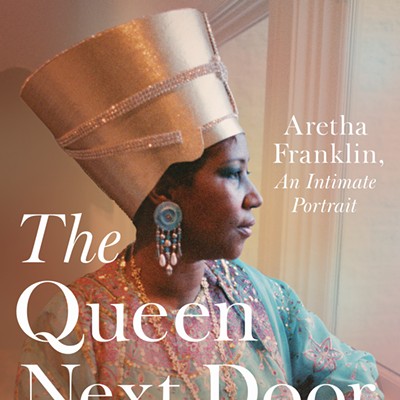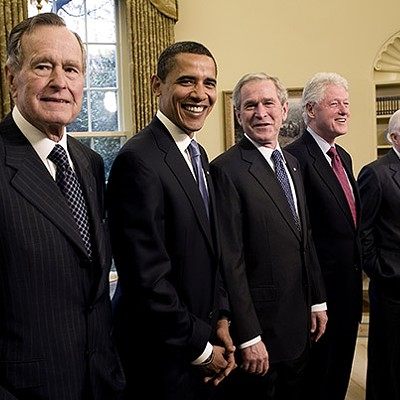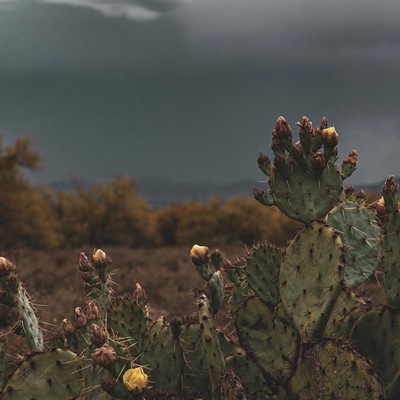"The UA had hired a search firm and they were soliciting advice" about a new director, said Nickel, who took on the job of CCP director himself July 1.
"I said, 'I guess you're looking for a charismatic fund-raiser type. It's not what the center needs. (If you hire such a person), you'll look back in five years and the place will not have changed. It needs to re-think WHY it exists.'
"That didn't go over well."
But the headhunter called back and said the search committee was intrigued by Nickel's comments. He ended up writing a proposal, and almost inadvertently, he became a candidate for the director's job.
"My proposal to the center was that it could be a place that bridges the gap between the museum and scholarly worlds," he said. "My vision came out of my funny status."
That "funny status," straddling the museum and academic worlds, started when he was an honors undergraduate at Cornell studying art history. Even then, when he was ostensibly preparing for a career in academe, he did his own photography and he worked in the university art museum. Likewise, when he was studying at Princeton for his doctorate, he worked in the university art museum, and undertook such tasks as matting and framing.
During his years as curator at the San Francisco Museum of Modern Art, he logged hours in the classroom as an adjunct professor at UC Berkeley and Stanford. He believes that the Center for Creative Photography, a museum placed squarely on the campus of a major research university, is uniquely positioned to perform a similar balancing act.
Front and center on his agenda is the development of what he's calling the Institute for Photographic Research, which, he declares, "has the potential to become the pre-eminent training ground for the next generation of photography curators."
Nickel envisions the new institute bringing in photography stars and scholars to do residencies for a semester or a year. The center would benefit by getting increasing renown as a scholarly site, and the UA students would benefit by drawing on the scholars' expertise and contacts.
"You have to make it happen, be more proactive É turn it into a site," said Nickel, who believes that the concept is exciting enough to lure big money from donors, even in these days of strapped budgets. "Give it a name; do fund-raising. Attract students. Begin a more useful dialogue with the art history and art department. É Make it a required internship for graduate students in photographic history. Put it on the transcript."
Nickel moved to Tucson in the heat of summer with his wife, Genoa Shepley, a freelance writer and researcher, after the couple traded in their 1912 San Francisco bungalow for a 1941 art moderne house near the Arizona Inn. He sat for an interview recently in his new CCP office, which with its papers and books strewn about was as untidy as he himself is buttoned-down. Dressed in a blue-checked shirt and khakis, he looked more like a professor than an art-world trendy.
He expects to keep up his dual life in his new job. As a tenured associate professor of art history, he'll start teaching classes next fall.
While he praises the "excellence" of the 28-year-old center's exhibitions and its staff, he said, there's always been a "piece missing. É The rationale for the center existing on a university campus was not given a lot of thought. Inevitably, tensions were going to arise when the university tried to pull it back."
"Tensions" is an understated description of the bruising battle that has raged between the center and the UA in recent years. Placed under the authority of the library ever since its founding by Ansel Adams and then-UA president John Schaefer, the center began chafing under the arrangement after Carla Stoffle arrived as dean of libraries. Stoffle has exerted more control over the center than previous deans did, and three years ago, she fired the center's last director, Terence Pitts. In the years since, much of the professional staff has fled, most notably acclaimed curator Trudy Wilner Stack.
When he took the call from the headhunter, Nickel said he was well aware of the center's problems.
"I was a little dismayed at the state of things," he acknowledged.
The lines of authority have not changed--a press release announcing Nickel's appointment made a point of stating in the second paragraph, "He will report to Dean of Libraries and CCP Carla J. Stoffle, who is delighted with his appointment." Nickel prefers to discuss the center's future, he said, and he's hoping that most of its problems are now are in the past.
"Before I got here. things were improving," he said. "We do have a responsibility to our parent organization, the library, (but) as a good parent knows, letting kids run off and explore (is important). Our success is their success."
Nickel said he's been given the go-ahead to hire new staff members. Right now, he's looking for a preparator, and after that, he'll search for a full-time fund-raiser, a first for the center, then a curator and a publications and press professional. And he's been busily lining up exhibitions. When he arrived July 1, there were no shows planned beyond the Weston-Mather exhibition, which is scheduled to come down Oct. 12.
To fill that looming gap, Nickel quickly booked a show of work by Emmet Gowin, an aerial photographer who has a roundabout link to the center: He was a student both of Harry Callahan and Frederick Sommer, whose work was among the center's founding archives. Beyond that is a tribute to Harold Jones, the UA photographer and prof who was founding director of the center, and Evidence, a show that takes evidentiary photos from police archives and insurance company files, and exhibits them stripped of their context.
Nickel said he was misquoted in an Arizona Daily Star story that said he would stage just one major exhibition once every year and a half. In reality, he plans the usual lineup of about five exhibitions a year, with the occasional show getting the full scholarly treatment of a major catalog and an accompanying symposium.
"The center would be wise to do one big blowout show every year and a half," he explained, along the lines of 2001's Garry Winogrand double exhibition and symposium organized by Wilner Stack, a project he called a "great thing."
While the center's strength is in its archives of 20th-century photographers, Nickel has thus far made his greatest splash in his studies of the 19th century. His doctoral dissertation, on Victorian photographer Francis Firth, a devout Quaker who photographed the Holy Land in order to prove the truth of the Bible, will be published as a book this fall by Princeton University Press. A big Lewis Carroll exhibition he curated for the San Francisco Museum of Modern Art, Dreaming in Pictures, just closed at the International Center of Photography in New York. And he put together the first major exhibition on Carleton Watkins, a 19th-century photographer who traveled the West, including in Tucson. He wrote catalogs for both exhibitions.
Nevertheless, Nickel said he feels eminently comfortable working in the 20th century. His honors thesis at Cornell was on Walker Evans. At Princeton, he specialized in not only in the history of photography and American art, but in modern art, he pointed out. And he worked on numerous shows in San Francisco on modern photographers, not the least of them the centenary exhibition of Ansel Adams, curated by his friend and mentor, John Szarkowski, director emeritus of the photography department at the Museum of Modern Art in New York. (Szarkowski was a professor-at-large at Cornell when Nickel was an undergrad.)
For the future, Nickel wants to update the center's Web site, which he said right now is more advertisement than research tool. "My five-year plan is to get the collection available to uses on the Web site. Part of the message here is to use technology to give access to what we have. That's what the library is about. They have the experts."
That goal, he said, in no way contradicts his responsibility to care for the one-of-a-kind objects in the center's collection.
"The experience of the original object is king," he said. The Web site "better safeguards the objects" by allowing, for instance, a professor in Los Angeles to page through the virtual collection to make a preliminary assessment of what's available instead of handling the actual prints.
Stoffle moved to cut back the hours of the center's highly regarded photography library in the months before Nickel arrived. Last school year, the library was open seven hours daily on weekdays, and four hours on Sunday afternoons. Its photography reference librarian has now been reassigned to a fledgling fine arts library in the music school, and the CCP library hours have been cut to four hours a day on weekday afternoons only. A student worker presides over the vast collection of books, journals, ephemera, videotapes and rare books.
"The library has gone to great lengths to see that nobody is inconvenienced," Nickel said, noting that during the morning hours, students can page books via computer. (Nevertheless, on a recent weekday when I called the center, a student answering the phone could not give me the number to the fine arts reference desk. When I succeeded in getting the number elsewhere, a call to the reference desk was not picked up, even after 16 rings.)
The goal, as Stoffle has stated, is to one day build a new state-of-the-art fine arts library. Nickel said he would welcome getting the extra space if the photography collection moves in the future.
"Our building was designed in 1989. We're outgrowing the building. É The new building will give us the opportunity to expand."
In the meantime, Nickel hopes that his expertise at jumping boundaries will help to bring together the center's disparate camps, from its staff to the library leaders, to the fans of its contemporary shows and proponents of exhibitions from its own collections. As a curator, he says, he "chafes at false dichotomies." Both the Lewis Carroll and the Ansel Adams shows he worked on, he said, uncovered new ways of thinking about extremely familiar figures. The Carroll show challenged the conventional contemporary view that there was something unseemly in the photographer's photos of children, and the Adams show looked at the beloved photographer's earlier, modernist prints.
"Maybe there's more to the story than we ever imagined," he said.
The same could be true of the center.
"I don't think a choice needs to be made," he said, "between contemporary and historical, between the borrowed and the collection. The exhibition program does need to reflect the identity of the center. It's how it's done, not what it shows."
He's optimistic that the center's strengths will carry it through.
"People here have been through a rough patch and have stuck it out. Our collections are world-class. É We're a research center/gallery/archive. We're the only place like that."














